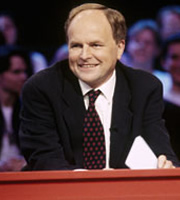 It isn't unusual for television and movie buffs to hear the following remarks:
It isn't unusual for television and movie buffs to hear the following remarks:The book version is better.I'll refute the first two at a later time, but I want to deal with the last right now. It isn't atypical for us Americans to feel rather ashamed of our supposedly crass culture, to assume that other countries only produce worthwhile and artistically sensitive programming.
Regular programming is so trite.
The British version is better . . .

This is completely silly--there's as much good and bad programming in Japan and France and Great Britain as anywhere else. In fact, in general, American programming produces more decent shows simply due to volume (we produce more crappy shows too; we just produce more shows in general).
I'm a fan of a many BBC shows from The Vicar of Dibley to Doctor Who to Poirot. And I wish that many BBC quiz shows were more easily obtainable.
However, I recently tracked down the BBC Whose Line Is It Anyway? which preceded the American version (of the same title) by about a decade. And I have to say: although I'd been told that the BBC version was wittier, etc. (everything British is better!), I consider the American seasons I've seen of far higher quality than the initial BBC seasons. (Yes, there are caveats: keep reading.)
1. The stand-up comics in the BBC version don't always follow the rules.
 |
| Astounding Ryan Stiles and adorable Colin Mochrie |
Granted, the rules in both shows don't mean much. But many of the jokes arise from trying to meet those rules. In the first season of the American version, Ryan Stiles and Colin Mochrie (who both also starred in the British version) have to do a routine about vampires. At one point, Colin, who is being manipulated by an audience member, mutters to Ryan's chest, "I forgot my stake, so I'm going to have to chew through your chest."
The equivalent British version of this, on the other hand, would morph into something totally different and far less funny.
The best example of the difference here is the British "game" in which the comics had to mimic authors' styles while telling parts of a story. One of the British comics would always, always, always do the same thing: pick a pretentious writer and mimic him (or her). It was funny once but after awhile . . . And he would never try to get his spoof to match up to the assigned topic. He'd just go off on a tangent.
This was so common that at one point, the host--Clive Anderson--remarked rather testily that no one was getting any points because no one actually kept on-target.
2. The American version is more versatile.
Now at this point, I will acknowledge that the American version built off the British version. The American version also started with the amazing Ryan Stiles and Colin Mochrie (Ryan joined the British version in its second season; Colin two seasons later). Consequently, the American version was able to begin with many of the edges smoothed off plus a leg up on physical comedy.
Now, I'm not a huge fan of slapstick. However, this type of show really needs pure physical comedy. Ryan Stiles, when he acts like a hunted deer, and Colin Mochrie, when he acts like a bad trapeze artist, or both of them ("It's a disaster! What should we do? Run from side to side!") are hilarious.
They are also the kind of comics who think alike and are therefore able to produce very funny routines where one guy picks up where the other guy left off.
The first seasons of the British version don't have any of this (I will allow that it may have changed later on). It is terribly talky--and I'm the kind of person who usually loves witty dialog! But still, for a show of this type, you need physical comedians.
3. The American version has Wayne Brady as a regular.
 |
| Wayne Brady |
 |
| The kindly Clive Anderson |
Again, this may be because the American version got the show after it had already been tested. But Greg Proops, who is a seriously funny comic worthy of Phil Hartman (rest in peace), seems far more ill-at-ease--and somewhat under-appreciated--in the British version than in the American version.
I don't think this is the host. Clive Anderson has a friendly Drew Carey quality (what is about game show hosts?). Rather, it seems to be the other comics. In the British version, they all seem to be trying so hard to be funny in their own right. While in the American version, they will often play off each other.
So, while I will grant that the American show likely benefited greatly from the British show going first and working out the kinks, I just want to go on record: the British version of something is NOT automatically the best version. That equation does work both ways.
No comments:
Post a Comment